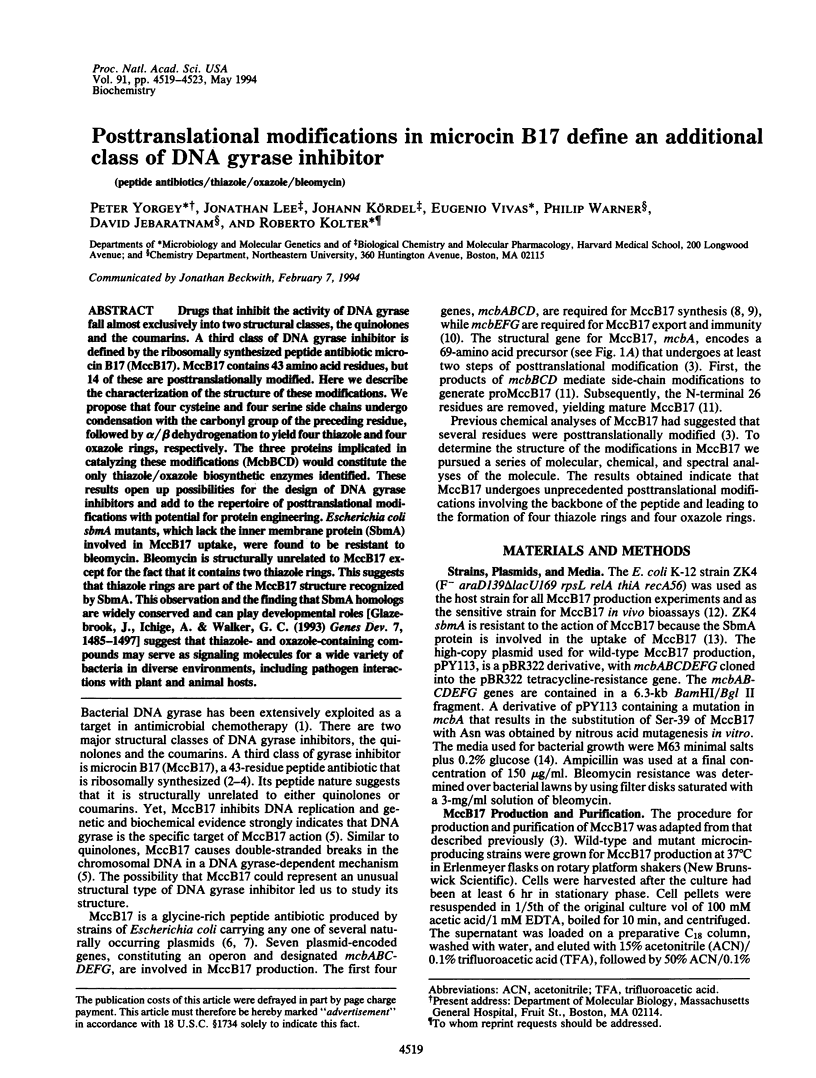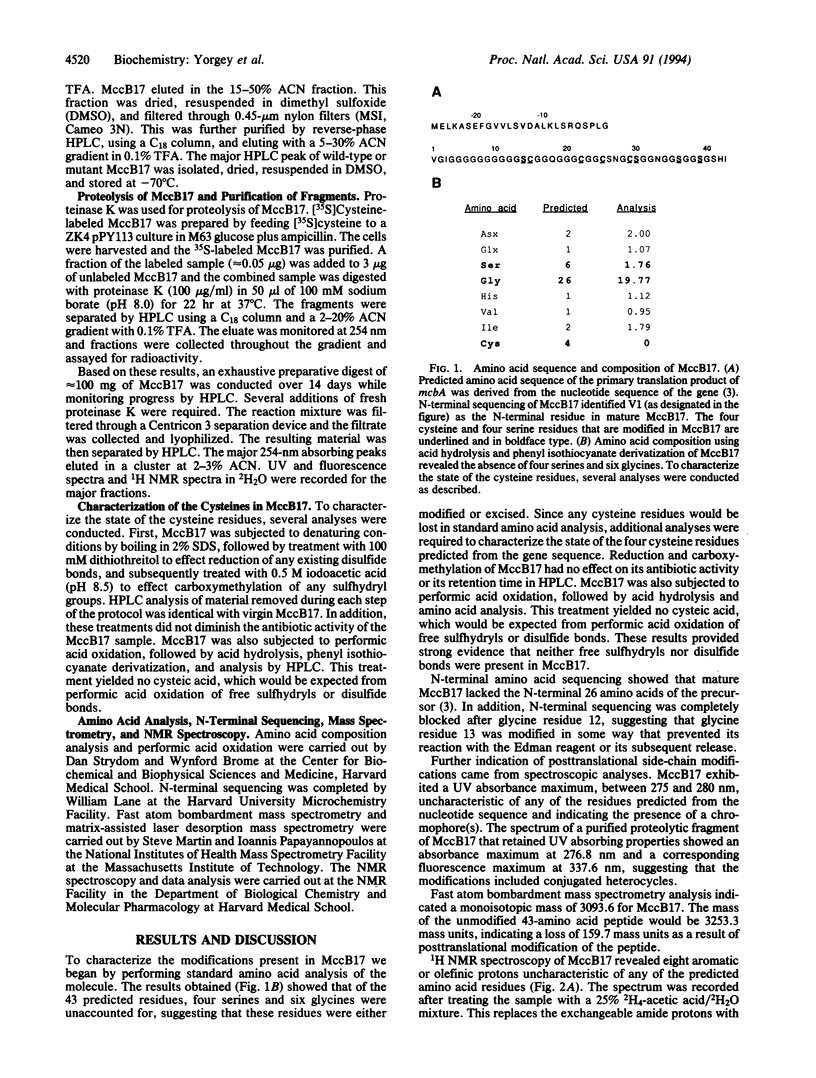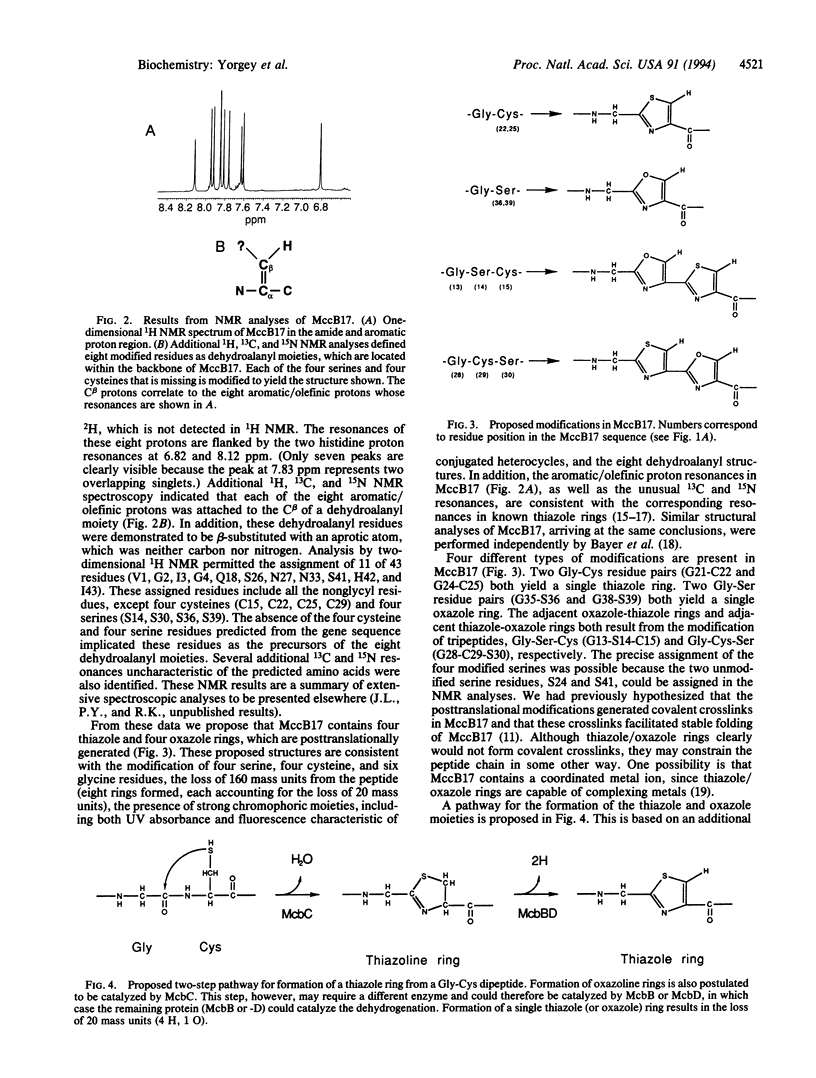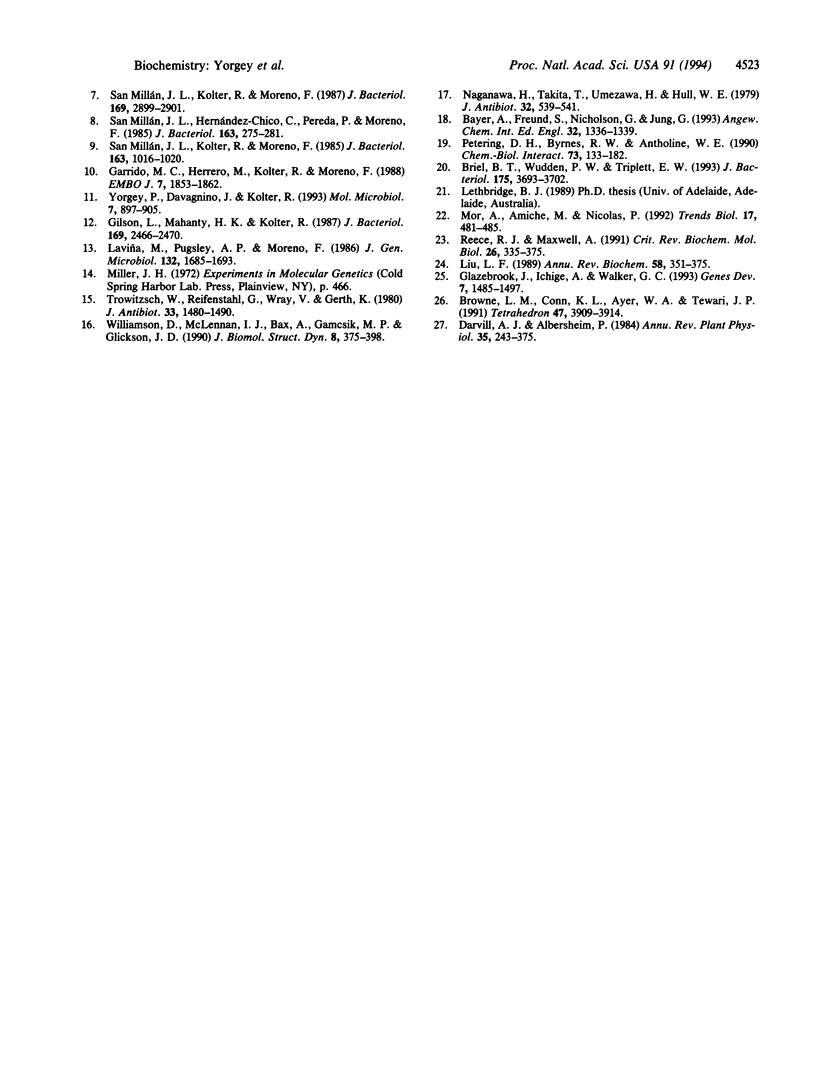Abstract
Drugs that inhibit the activity of DNA gyrase fall almost exclusively into two structural classes, the quinolones and the coumarins. A third class of DNA gyrase inhibitor is defined by the ribosomally synthesized peptide antibiotic microcin B17 (MccB17). MccB17 contains 43 amino acid residues, but 14 of these are posttranslationally modified. Here we describe the characterization of the structure of these modifications. We propose that four cysteine and four serine side chains undergo condensation with the carbonyl group of the preceding residue, followed by alpha/beta dehydrogenation to yield four thiazole and four oxazole rings, respectively. The three proteins implicated in catalyzing these modifications (McbBCD) would constitute the only thiazole/oxazole biosynthetic enzymes identified. These results open up possibilities for the design of DNA gyrase inhibitors and add to the repertoire of posttranslational modifications with potential for protein engineering. Escherichia coli sbmA mutants, which lack the inner membrane protein (SbmA) involved in MccB17 uptake, were found to be resistant to bleomycin. Bleomycin is structurally unrelated to MccB17 except for the fact that it contains two thiazole rings. This suggests that thiazole rings are part of the MccB17 structure recognized by SbmA. This observation and the finding that SbmA homologs are widely conserved and can play developmental roles [Glazebrook, J., Ichige, A. & Walker, G. C. (1993) Genes Dev. 7, 1485-1497] suggest that thiazole- and oxazole-containing compounds may serve as signaling molecules for a wide variety of bacteria in diverse environments, including pathogen interactions with plant and animal hosts.
Full text
PDF




Selected References
These references are in PubMed. This may not be the complete list of references from this article.
- Baquero F., Bouanchaud D., Martinez-Perez M. C., Fernandez C. Microcin plasmids: a group of extrachromosomal elements coding for low-molecular-weight antibiotics in Escherichia coli. J Bacteriol. 1978 Aug;135(2):342–347. doi: 10.1128/jb.135.2.342-347.1978. [DOI] [PMC free article] [PubMed] [Google Scholar]
- Breil B. T., Ludden P. W., Triplett E. W. DNA sequence and mutational analysis of genes involved in the production and resistance of the antibiotic peptide trifolitoxin. J Bacteriol. 1993 Jun;175(12):3693–3702. doi: 10.1128/jb.175.12.3693-3702.1993. [DOI] [PMC free article] [PubMed] [Google Scholar]
- Davagnino J., Herrero M., Furlong D., Moreno F., Kolter R. The DNA replication inhibitor microcin B17 is a forty-three-amino-acid protein containing sixty percent glycine. Proteins. 1986 Nov;1(3):230–238. doi: 10.1002/prot.340010305. [DOI] [PubMed] [Google Scholar]
- Garrido M. C., Herrero M., Kolter R., Moreno F. The export of the DNA replication inhibitor Microcin B17 provides immunity for the host cell. EMBO J. 1988 Jun;7(6):1853–1862. doi: 10.1002/j.1460-2075.1988.tb03018.x. [DOI] [PMC free article] [PubMed] [Google Scholar]
- Gilson L., Mahanty H. K., Kolter R. Four plasmid genes are required for colicin V synthesis, export, and immunity. J Bacteriol. 1987 Jun;169(6):2466–2470. doi: 10.1128/jb.169.6.2466-2470.1987. [DOI] [PMC free article] [PubMed] [Google Scholar]
- Glazebrook J., Ichige A., Walker G. C. A Rhizobium meliloti homolog of the Escherichia coli peptide-antibiotic transport protein SbmA is essential for bacteroid development. Genes Dev. 1993 Aug;7(8):1485–1497. doi: 10.1101/gad.7.8.1485. [DOI] [PubMed] [Google Scholar]
- Kolter R., Moreno F. Genetics of ribosomally synthesized peptide antibiotics. Annu Rev Microbiol. 1992;46:141–163. doi: 10.1146/annurev.mi.46.100192.001041. [DOI] [PubMed] [Google Scholar]
- Laviña M., Pugsley A. P., Moreno F. Identification, mapping, cloning and characterization of a gene (sbmA) required for microcin B17 action on Escherichia coli K12. J Gen Microbiol. 1986 Jun;132(6):1685–1693. doi: 10.1099/00221287-132-6-1685. [DOI] [PubMed] [Google Scholar]
- Liu L. F. DNA topoisomerase poisons as antitumor drugs. Annu Rev Biochem. 1989;58:351–375. doi: 10.1146/annurev.bi.58.070189.002031. [DOI] [PubMed] [Google Scholar]
- Mor A., Amiche M., Nicolas P. Enter a new post-translational modification: D-amino acids in gene-encoded peptides. Trends Biochem Sci. 1992 Dec;17(12):481–485. doi: 10.1016/0968-0004(92)90333-5. [DOI] [PubMed] [Google Scholar]
- Naganawa H., Takita T., Umezawa H., Hull W. E. Chemistry of bleomycin. XXIII. Natural abundance 15N-NMR spectroscopic evidence for the structure of bleomycin. J Antibiot (Tokyo) 1979 May;32(5):539–541. doi: 10.7164/antibiotics.32.539. [DOI] [PubMed] [Google Scholar]
- Petering D. H., Byrnes R. W., Antholine W. E. The role of redox-active metals in the mechanism of action of bleomycin. Chem Biol Interact. 1990;73(2-3):133–182. doi: 10.1016/0009-2797(90)90001-4. [DOI] [PubMed] [Google Scholar]
- Reece R. J., Maxwell A. DNA gyrase: structure and function. Crit Rev Biochem Mol Biol. 1991;26(3-4):335–375. doi: 10.3109/10409239109114072. [DOI] [PubMed] [Google Scholar]
- San Millan J. L., Hernandez-Chico C., Pereda P., Moreno F. Cloning and mapping of the genetic determinants for microcin B17 production and immunity. J Bacteriol. 1985 Jul;163(1):275–281. doi: 10.1128/jb.163.1.275-281.1985. [DOI] [PMC free article] [PubMed] [Google Scholar]
- San Millán J. L., Kolter R., Moreno F. Evidence that colicin X is microcin B17. J Bacteriol. 1987 Jun;169(6):2899–2901. doi: 10.1128/jb.169.6.2899-2901.1987. [DOI] [PMC free article] [PubMed] [Google Scholar]
- San Millán J. L., Kolter R., Moreno F. Plasmid genes required for microcin B17 production. J Bacteriol. 1985 Sep;163(3):1016–1020. doi: 10.1128/jb.163.3.1016-1020.1985. [DOI] [PMC free article] [PubMed] [Google Scholar]
- Trowitzsch W., Reifenstahl G., Wray V., Gerth K. Myxothiazol, an antibiotic from Myxococcus fulvus (myxobacterales). II. structure elucidation. J Antibiot (Tokyo) 1980 Dec;33(12):1480–1490. doi: 10.7164/antibiotics.33.1480. [DOI] [PubMed] [Google Scholar]
- Vizán J. L., Hernández-Chico C., del Castillo I., Moreno F. The peptide antibiotic microcin B17 induces double-strand cleavage of DNA mediated by E. coli DNA gyrase. EMBO J. 1991 Feb;10(2):467–476. doi: 10.1002/j.1460-2075.1991.tb07969.x. [DOI] [PMC free article] [PubMed] [Google Scholar]
- Williamson D., McLennan I. J., Bax A., Gamcsik M. P., Glickson J. D. Two-dimensional nMR study of bleomycin and its zinc(II) complex: reassignment of 13C resonances. J Biomol Struct Dyn. 1990 Oct;8(2):375–398. doi: 10.1080/07391102.1990.10507811. [DOI] [PubMed] [Google Scholar]
- Yorgey P., Davagnino J., Kolter R. The maturation pathway of microcin B17, a peptide inhibitor of DNA gyrase. Mol Microbiol. 1993 Aug;9(4):897–905. doi: 10.1111/j.1365-2958.1993.tb01747.x. [DOI] [PubMed] [Google Scholar]


